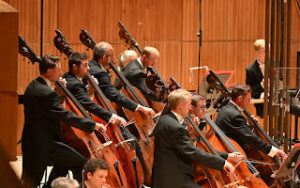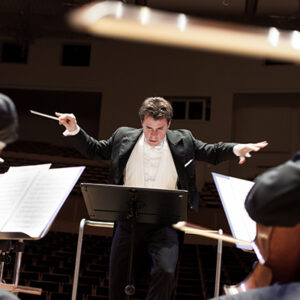Philharmonia Orchestra
Jakub Hrusa (conductor)
Stephen Isserlis (cello)
Royal Festival Hall
24 March 2024
This was an all-Russian concert which had you pretty much on the edge of your seat throughout. As soon as Jakub Hrusa started Mussorgksy’s Night on a Bare Mountain at an electifyingly fast tempo, it was clear this was going to be something quite special. No chance, or need, of a “warm up” for this orchestra in this fired-up mood.
One of the best things about the opener was the excellent double bass section, all eight of then leaping from pizzicato to arco so fast that one could barely see their right hands moving. It underpinned the excitement, as did the growling tuba counterpointed so deftly against the piccolo, the sensitively managed contrasts and the beautiful melody first introduced by the violas.

Photo by Mark Allan
Now, I have to confess that Kabalevksy’s 1964 cello concerto was new to me but I now agree with soloist Stephen Isserlis who played the UK debut in 1981. He says in his programme interview that he can’t understand why it isn’t played more often and better known. It’s full of the sort of soulful anguish which dogged Russian artists in the 1960s and very reminiscent of Shostakovich. Isserlis played the startling opening pizzicato section with dramatic freshness and treated us to a great deal of passionate and energetic virtuoso playing thereafter – keeping an occasional eye on his music stand, presumably because he doesn’t get the chance to play this intriguing, compelling piece all that often. It’s performed seamlessly without movement breaks so it felt pretty intense. Eventually, though Isserlis and Hrusa steered, through the anguish, towards the hesitant but beautiful melody at the end: a resolution of sorts.
Then, Isserlis told the audience that “ While we’re in Kabalevsky mode” he would play the composer’s Study in Major and Minor as his encore. It’s short, witty and good fun – and very different from the concerto.
Everyone who entered the hall via Door G stopped to look at the four huge, cathedral-size, cast bells at downstage left, each engraved with its provenance. This was clearly going to be Pictures at an Exhibition with a difference. Most of us are used to Ravel’s orchestration of Mussorgsky’s piece so to hear Stokowskii’s exuberantly exhilarating arrangement, played with all the panache the Philharmonia can muster, was quite an experience.
The opening Promenade is, in this version, given to the strings who are then allowed to build to a lush American sound. There were really too many high spots to mention but I particularly liked the beautifully played bassoon in duet with the saxophone, the quality of horn and brass work in the Bydio section and the chickens sounding really avian – lots of glissandi – in the Ballet of the Chickens in their Shells along with the arresting grotesqueness in Baba Yaga. And so, finally, to the grandiloquence of The Great Gate of Kyiv, those evocatively sonorous bells and a hugely exaggerated rall which worked a treat in this context.
The orchestra required for this work was enormous: two piccolos, two harps, double brass, celeste, organ and big string sections. That’s probably why we don’t hear it very often in this arrangement. So all credit to the Philharmonia for pushing the boat out so powerfully.
